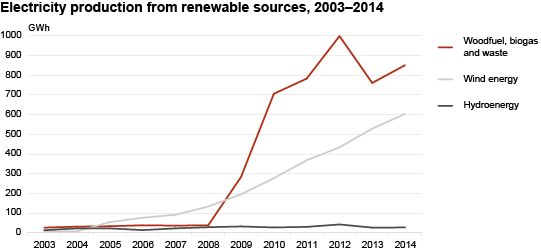Analytics, Energy, Estonia
International Internet Magazine. Baltic States news & analytics
Friday, 26.04.2024, 12:30
Electricity production in Estonia decreased by 6% in 2014
 Print version
Print version
The main reason for decreased production was the possibility to import cheaper electricity from the Nordic countries. Import from Finland grew 1.5 times in 2014 compared to the year before and represented more than 97% of total energy imports. At the same time, due to slightly colder weather conditions, the inland consumption of electricity increased more than 1% year over year.
The introduction of renewable sources has reduced the importance of oil shale in electricity production. In 2014 compared to 2013, the consumption of oil shale in power plants decreased nearly 5%. In 2010, over 85% of electricity was generated from oil shale, whereas in 2014 this share was 82%. As a result of increased consumption of wood in combined heat and power plants, about a half of renewable electricity was produced from biomass. The implementation of environmental projects has boosted waste treatment and has greatly increased the consumption of waste fuel and biogas for electricity generation.

With the development of new wind farms, the production of wind energy has also increased. In 2014 compared to 2013, the production of wind energy increased 14%. At the same time, there was no change in the production of hydroenergy. In six years, the share of electricity generated from renewable sources in total electricity consumption has increased more than twice, from 6.2% in 2009 to 15.3% in 2014.
In the last five years, the volume of oil shale production has increased every year, reaching 21 million tonnes in 2014, which is over 2% more compared to 2013. The majority of oil shale is consumed in power plants, but the growth in shale oil production has increased the consumption of oil shale as raw material for shale oil. In 2014 compared to 2013, the production of shale oil increased nearly 12%, whereas most of the production was exported. Nearly a third (33%) of this amount was exported to Belgium, followed by the Netherlands (20%) and Sweden (8%).
Over the last five years, the production of wood pellets has increased more than two times. Compared to 2013, the production of pellets grew nearly 25% in 2014. Over 90% of the wood pellets produced were exported – more than a half (54%) to Denmark, followed by Italy, Sweden and the United Kingdom each with about 8% of exports.
The production of peat fuels has shown a downward trend in the last five years. In 2014 compared to 2013, the volume of production did not change much.








 «The Baltic Course» Is Sold and Stays in Business!
«The Baltic Course» Is Sold and Stays in Business!

